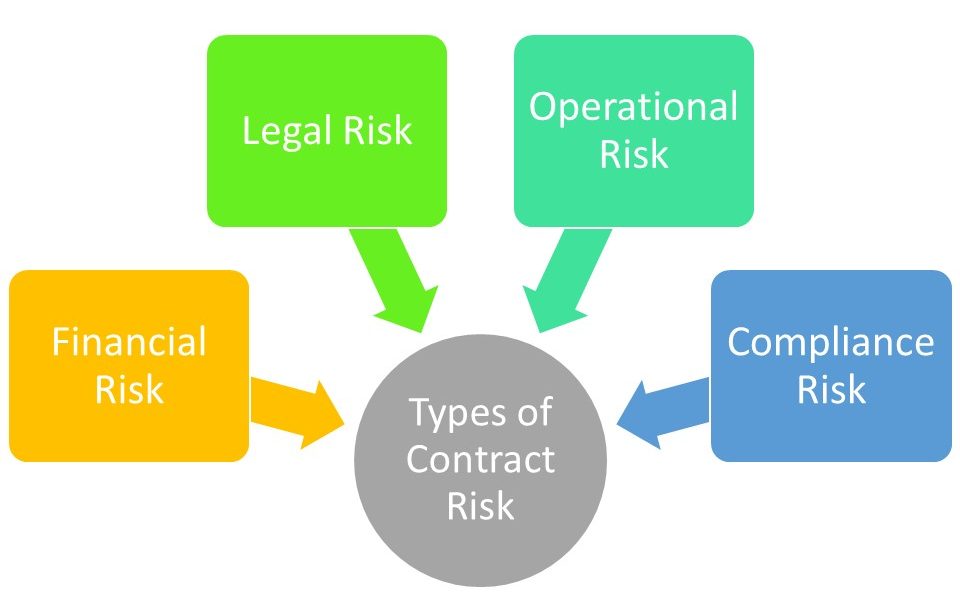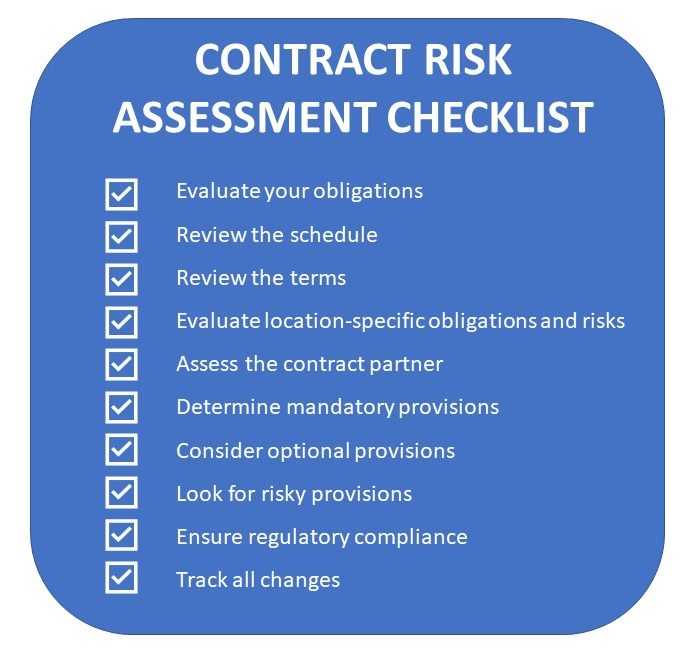Contract Risk Assessment Checklist: 10 Steps to Follow
In this post, you’ll learn how to create a contract risk assessment checklist for your organization.
Assessing contract risk is essential, as any given contract can put your entire operation at risk. To reduce the overall risk to your organization, you need to mitigate the risk associated with each agreement. One important way to do that is to put together a contract risk assessment checklist for each contract you enter into.
What should that checklist entail? Read on to find out.
Key Takeaways
- To help minimize contract risk, create a checklist that assesses various types of risks for each contract.
- Your contract risk assessment checklist should include evaluating obligations, reviewing the schedule and terms, and assessing the contract partner.
- Also important is determining mandatory provisions, looking for risky provisions, and ensuring regulatory compliance.
Why Contract Risk Assessment is Important
Contract risk is assessed based on the probability and consequence of the risk and can be defined as the possibility of some clause or term in a contract harming your organization.
Contracts can expose your organization to:
- Financial risks
- Legal risks
- Compliance risks
- Operational risks

Your company can’t operate risk-free. You know that you need to take reasonable risks to maximize your business’ growth and profits. It’s important, then, to recognize those risks you take and minimize their potential effect. You can do this by conducting a risk assessment for each new contract you create.
If you pay attention to the risks you identify, you’ll lower the chance of losing money, being sued, being fined, or suffering operational difficulties.
The 10-Step Contract Risk Assessment Checklist
An important component of any contract risk management strategy is to create a contract risk assessment checklist and then work through that checklist for new contracts. This checklist should identify potential areas of risk and quantify those risks.
The process of working through the checklist will help you identify, mitigate, and manage the risks your organization faces daily.
1. Evaluate Your Obligations
The first item on your contract risk assessment checklist is to evaluate the scope of the contract. You should ask the following questions:
- What are your obligations under the contract?
- Can you deliver on these obligations?
- How much time and money will be involved in meeting these obligations?
- Are there any “gray areas” where your obligations are not clearly defined and could end up in dispute?
Once you’ve effectively evaluated your obligations, the next step is determine how you will manage those obligations by reviewing the schedule.
2. Review the Schedule
A contract obligates you to certain deliverables on a specified timetable. You need to be aware of the following:
- The schedule of deliverables and whether you can meet the delivery dates
- Penalties involved if you miss the dates – that is, the financial risk associated with committing to a schedule
- The risks if your contract partners do not adhere to their contracted delivery dates
Managing contract obligations and deliverables is a critical risk management function. With contract management software, you can set automated alerts and reminders for obligations such as a renewal date, termination window, the need to send a client a quarterly report, or some other key commitment. It makes obligation management much more automated and accurate.
3. Review the Terms
Most contracts involve a financial transaction. Either you’re paying the other party for something or they’re paying you. You must review the pricing and payment terms to make sure that the terms are fair to both parties. You don’t want to enter into an agreement in which you’re overpaying – or be underpaid for delivering products or services to a client.
With contract management software, you can easily track contract line items such as product pricing, payment schedules, and many other financial aspects of the agreement. You can also set automated workflows to ensure contracts with certain dollar values get reviewed and approved by the appropriate people in the organization.
4. Evaluate Location-Specific Obligations and Risks
Many contracts are entered into with vendors or customers who operate in different locations. Some locations, especially foreign ones, pose their own risks. These risks may involve local rules and regulations, such as the EU’s GDPR privacy regulations, which are different from what you’re accustomed to in the U.S.
Other location-specific risks may impact product quality, delivery time, or even the monetary exchange rate. Think through all aspects of contracting with distant partners. To assess these risks, it’s important to have the ability to report on all your contracts by organization, location, and even key legal language that may be geographically-specific. Contract management software from Contract Logix makes all of this possible in a real-time fashion.
5. Assess the Contract Partner
Doing business with some new vendors, customers, partners or other third parties can be riskier than others. It’s important to properly assess the other organization’s reputation, reliability, policies, principles, and stability.
For example, if security is a concern, do they have the proper security protocols and certifications in place like SOC 2 Type II compliance, employee background checks, data privacy, etc.? And what about their financial performance? Or, how do they treat their employees and what are their guiding principles? These are just some of many items you may want to assess when entering into a contract with a new party. It’s also critical to ensure all of the supporting documents for the contract are in place and up-to-date like a Certificate of Insurance (COI). A modern contract management solution can help you centralize and track all of this information so that it is at your fingertips when you need it.
6. Determine Mandatory Provisions
Your company should have a list of terms and conditions that need to be included in all your contracts.
These mandatory provisions may include:
- Payment terms
- Limitation of liability
- Damage waiver
- Non-disclosure
Whatever mandatory provisions your company entails, make sure they’re included in each new contract in which you engage. Contract Logix’s data-driven CLM software has an easy-to-use Clause and Template library for drafting agreements with all your pre-approved legal language. You can even set conditional rules to determine which clauses and templates to use based on different factors associated with the agreement. This provides a significant increase in compliance and goes a long way to help mitigate your risk.
7. Consider Optional Provisions
Once you ensure that the contract contains your company’s mandatory provisions, you may want to consider other optional provisions you’d like to have included. Including these provisions may mitigate your risk to some degree; not including them may or may not significantly increase your risk. As mentioned in the mandatory provisions section, contract management software and the use of clause and template libraries can be a big help with ensuring the right provisions are included in the contract.
8. Look for Risky Provisions
One of the more important things you can do when assessing contract risk is to scour the contract for any provisions that carry a high degree of risk. These high-risk provisions may include the following:
- Tight schedules
- Complex deliverables
- Deliverables highly dependent on outside factors, such as deliverables from other parties
You should also look for any terms that, if not met, can result in breach of contract or hefty penalties.
9. Ensure Regulatory Compliance
All of your contracts must comply with all applicable government and industry regulations. Failure to comply puts you at risk of hefty fines and other penalties. Also consider the risk of whether delivering on a contractual obligation might result in noncompliance.
You’ll want to ensure you have a complete history of all activities associated with the contract to serve as an audit trail in the event you need to provide evidence of compliance. This is also very helpful when working through disputes about the contract. In addition, the use of tools like electronic signatures, document comparison, and real-time messaging help you keep track of everything required to execute the contract and ensure you have the latest and greatest contract. Contract Logix automates and streamlines all of this to drive a huge increase in compliance.
10. Track All Changes
A contract might start out relatively low risk but after negotiations, additions, redlining, and the like, it may end up with a higher degree of risk. You need to track all changes and amendments made to the contract and assess and minimize any new risks introduced during the process.
As mentioned above, CLM software functionality like document compare and automated version tracking make all of this easy and accurate. In addition, stage and status tracking giving you visibility into where the contract is in your process at all times. That, coupled with modern collaboration and negotiation technologies, ensure you have all your bases covered when it comes to edits and redlines.
Let Contract Logix Help Minimize Your Contract Risk
The best way to minimize contract risk is by deploying contract lifecycle management (CLM) software. The robust CLM solutions offered by Contract Logix automatically work through all the steps in the contract risk assessment checklist to protect against undue risk being introduced into the contract process.
Even better, our CLM software automates the entire contract process for your organization, which results in a more efficient, more accurate operation.
Contact Contract Logix today to learn more about using CLM software to reduce contract risk.




